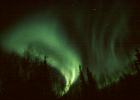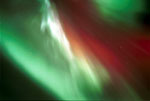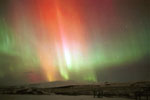 Edisi April 22, 2001 Edisi April 22, 2001 |
Dari Redaksi |
Rekan-rekan Alumni
Tak terasa sepekan telah berlalu. Kali ini CyberClips mengetengahkan tulisan mengenai
gejala alam Aurora, yang menarik untuk dicermati.
Bagi yang aktif menggunakan komputer, kami tampilkan link ke situs yang membahas prosedur
pemeliharaan yang akan bermanfaat bagi Anda.
Selamat berakhir pekan.  |
GOLF |
Get a grip on your swing
--by Johnny
Miller, NBC Sports

Note: The following segment first appeared during NBC's broadcast of the 2001 Bay Hill
Invitational on March 18.
The last couple years I've been playing a lot of golf with amateurs because I'm not
playing much competitive golf these days. I've noticed a couple little problems with most
players' grips. Sometimes I'll see the Vs formed by their thumbs and index fingers pointed
at their nose, or too far over to the right, or two different directions. That's not the
way the pros grip their clubs.
I'm going try and show you a typical PGA Tour grip.
I've marked my glove hand and right hand so you can see the Vs better. Put your left hand
on the club so the V is pointing just about at your right ear. The V of the right hand
should match. On the LPGA Tour, it's a little farther over to the right. The V is pointed
at the right shoulder.
This is a neutral position, which aligns your shoulders, elbows and everything in good
synchronization and allows you to make a level turn and put a nice, neutral hit on the
ball at the bottom.
One last point regarding the grip: don't grip it so darn tight. Grip it loose enough that
you can feel the golf club, feel the shaft, get a nice rhythm in your swing and make it
more effortless.
Work on those couple things and you'll find better results with your game.
|
BOWLING
TIPS |

EQUIPMENT
First, the equipment. Equipment should fit you perfectly. It
can mess up your hand later in life if you don’t size it right. Now there are three
types of grips, the conventional, the semi-fingertip, and the fingertip. The conventional
grip is for most beginning bowlers. The semi is almost out. It can be very hard to put
your hand in the same spot every time. The fingertip is for advanced bowlers. In the
conventional grip your thumb goes in all the way and your fingers go in all the way. In
the semi grip your thumb goes in all the way and your fingers go into the middle between
the first and second nuckle. Last, the fingertip. In the fingertip your thumb goes in all
the way and your fingers go to the first nuckle. Their is also a fingertip grip where you
don’t put in your thumb. I do not recommend this because it makes it hard to keep
control.
Next, the ball to use for the lane
conditions. On oily lanes I recommend a urethane ball or dull reactive resin. This is
because one of these ball will catch a lot sooner than a shiny. Shiny balls are usually
used for dry and medium lanes. There is also the difference between reactive resin and
urethane. Reactive resin hits harder and makes more of a snap. A urethane makes more of a
half circle. Urethane hooks sooner but does not snap very hard. Urethane keeps hooking
though unlike a reactive resin. Their are a couple other kinds of balls too, plastic and
polyester. Plastic and polyester balls are used for beginners and sometimes for spare
balls. This is because a plastic or a polyester doesn’t hook. This will take the
place of a reactive resin or urethane for a right-hander’s ten pin or six.
|
FAMOUS QUOTES |
If you want happiness for an hour, take a
nap.
If you want happiness for a day, go fishing.
If you want happiness for a year, inherit a fortune.
If you want happiness for a lifetime, help somebody.
(Chinese proverb)
|
|
KESEHATAN |
DIABETES
Diabetes is a disorder of metabolism--the way our bodies use
digested food for growth and energy. Most of the food we eat is
broken down by the digestive juices into a simple sugar called
glucose. Glucose is the main source of fuel for the body.
After digestion, the glucose passes into our bloodstream where it is
available for body cells to use for growth and energy. For the
glucose to get into the cells, insulin must be present. Insulin is a
hormone produced by the pancreas, a large gland behind the stomach.
When we eat, the pancreas is supposed to automatically produce the
right amount of insulin to move the glucose from our blood into our
cells. In people with diabetes, however, the pancreas either
produces little or no insulin, or the body cells do not respond to
the insulin that is produced. As a result, glucose builds up in the
blood, overflows into the urine, and passes out of the body. Thus,
the body loses its main source of fuel even though the blood
contains large amounts of glucose.
 Klik
untuk info lengkap Klik
untuk info lengkap |

|

Arsip Cyber Clips |
|
KOMPUTER |
PC MAINTENANCE
The home computer is a large investment and as such
should receive some basic attention on your part. The PC is a very sophisticated device,
however it is vulnerable to dust, dirt, tobacco residue, and a variety of other household
grime in many critical areas, the monitor, the mouse, the keyboard, the power supply, and
the central processor (CPU) to name a few. Dust and dirt can jam your keyboard switches,
foul the read/write heads on your disk drives or the laser pickup on your CD-ROM, and can
even cause your power supply to overheat. Smoke and dust degrade the quality of the
display on that super Monitor and can even cause intermittent connections in your
computer. These valuable tools should be cleaned periodically to decrease the probability
of system failure.
Visit a website that provides all the information Klik untuk info lengkap Klik untuk info lengkap
|
AURORA |
 The northern and southern lights, or auroras, are caused by a
gigantic, magnetic wrestling match that unleashes not solar, but earthly particles, to
create the brilliant night displays, scientists said Thursday.
Using data from NASA and Japanese spacecraft, scientists
with the International Solar-Terrestrial Physics program (ISTP) say they are the first to
find direct evidence to settle a 50-year-old controversy over the source of auroras.
The process relies, they say, on "reconnection,"
a union of solar and Earthly magnetic fields that lets the solar wind -- a flow of charged
particles from the sun -- punch through sections of the Earth's magnetic shell.

That process dices up magnetism into energy particles that
become the space weather storms known as the northern and southern lights.
"Reconnection is the fundamental process for
transferring and exchanging energy in the sun-Earth system," said Atsuhiro Nishida, a
researcher with the Japan Society for the Promotion of Science. Nishida also is with the
ISTP program.
"Reconnection on the dayside of Earth is critical for
allowing solar-wind energy to come into the magnetosphere. Nightside reconnection is
critical for the transfer of that energy down to the atmosphere."

Data settles debate
Until recently, scientists disagreed about the cause of
auroras, with some promoting the theory of reconnection. But recently, NASA's Polar
spacecraft flew through a region on the sunlit side of Earth to witness reconnection
directly. Also, scientists looked at data from Japan's Geotail spacecraft, which passed
through Earth's magnetic field and found the area on the nightside where reconnection
occurs. That gave scientists the data they needed to correlate reconnection with auroras.
The finding has business and lifestyle implications, as
solar weather can disrupt radio communications, spacecraft operations and power grids on
Earth. Extreme solar weather can harm astronauts in space. Understanding how solar weather
works could help us avoid scrambled communications and avert disaster.
Scientists think reconnection could be the key to
understanding solar flares and other solar eruptions, as well as the source of galactic
X-rays beyond our solar system and the process of nuclear fusion.

Torn cocoon
Before this finding, many believed auroras came about when
the particles spewing from the sun to Earth charged through our planet's atmosphere near
the North and South Poles.
In fact, the sun provides the energy, not the particles,
Nishida said. The particles were already there, trapped in Earth's magnetosphere. And the
process starts not at the poles but at "reconnective regions" elsewhere around
the globe.
To understand that, think of Earth's magnetic shell, or
magnetosphere, as a cocoon around the planet, said Jack Scudder, a University of Iowa
physicist who studies data from the Polar spacecraft.
"There are often times when the solar wind creates
tears in this cocoon, allowing charged particles and energy from the sun to enter the
space around Earth," he said. "This tearing -- reconnection -- is what we
directly observed with Polar."

Once the tears occur, the solar wind combines with the
magnetosphere to overload the system of magnetism nearby. That energy excites nearby
particles and causes another bounce and reconnection of magnetic fields that shoot energy
to the auroral zones at the Earth's poles and into its radiation belts.
In the past eight years, Geotail has studied Earth's
magnetosphere in search of colliding and combining solar and earthly magnetic fields --
reconnection. Geotail's success has helped scientists pinpoint the reconnection area --
about 85,000 to 96,000 miles (140,000 to 160,000 kilometers) downwind of Earth.
 Klik untuk info lengkap Klik untuk info lengkap
|
|
|
|
TOP MODEL |
BELINDA

 |
DIRGANTARA |

P51 Mustang
USA. 1944
This best known US fighter of WWII was built
to British requirements. The British reluctantly accepted North American's proposal to
design a new fighter for them, instead of license-building P-40's, and the USAAF was at
first not interested at all. The P-51 was a clean and very refined design, with a laminar
flow wing and carefully positioned radiator bath. The early P-51, with Allison V-1710,
engine, was an excellent low-altitude reconaissance fighter, but had low performance above
15000ft. After reengining with the R.R. Merlin, the P-51B was one of the best fighters of
WWII. It proved to be the ideal fighter to escort the bomber force on the long missions
over Germany. The P-51D sacrificed some speed for the introduction of a 'bubble' hood,
offering much better view. The P-51F, G and J versions were lightweight developments, with
only a superficial resemblance to the original Mustang; the P-51H was more directly
related to the P-51D, but powered by the more powerful V-1650-9 engine. After WWII, the
P-51D played a very important role as fighter-bomber in Korea. 14819 built.Type: P-51A
Function: fighter
Year: 1943
Crew: 1
Engines: 1 * 1200 hp Allison V-1710-81
Wing Span: 11.28 m
Length: 9.83 m
Height: 3.71 m
Wing Area: 21.65 m2
Empty Weight: 3110 kg
Max.Weight: 4812 kg
Speed: 628 km/h
Range: 2011 km

S37 BERKUT
Russia, 2000
Sukhoi Fifth-generation Fighter Philosophy
The FSW is a better performer at high angles of attack in post-stall manoeuvring much
needed in close-in dogfight. The fact that Simonov had chosen FSW for his fifth-generation
fighter once again confirms Sukhoi's commitment to the superagility as a crucial
requirement for the next generation air-superiority fighter. This approach, so much
different from western concepts of stealth, supercruise and BVR engagements, was taken to
the limits in Su-37. The FSW S-32 fitted with TVC expected to outperform its stalemate in
close-in dogfight involving post-stall flight regimes. Having the edge in manoeuvring, the
S-32 is clearly catching up in stealth with US and European new-generation fighters.
However even with its internal weapon bay and RAM coating, the new Sukhoi is a very
different concept than F-22. The heavy accent on RAM rather than radar absorbing
structures (RAS) is obvious. The reason for such attitude is not clear, although a
combination of the technology limitations and operational doctrine is most likely
candidate. The major components of radar stealth -- RAM coatings and surface quality --
are subject to the production and maintenance tolerance as it was shown by USAF F-117 and
B-2 operational experience. Untightened screws, scratches or unfastened access panels were
known to greatly deteriorate the RCS of the aircraft, reducing the engineering efforts put
into aircraft design. It remains to be seen how Sukhoi will overcome the looser production
standards of the Russian aircraft plans.
The Afghanistan experience where Sukhoi's encountered a
thread of the shoulder launched infrared homing surface-to-air missiles such as Redeye,
Stinger and SA-7, forced Sukhoi team to work on the reduction of the infrared signature of
the Su-25. The results materialized in the Su-25T development -- Su-25TM (Su-39 in
Sukhoi's nomenclature). The installation of the intake cones hiding the turbine blades and
efficient mixing of the exhaust with cold air reduced the IR signature of the Frogfoot
from front and rear aspects. This fourfold reduction at expense of 2% lower SFC is indeed
an impressive achievement. Further experiments with low visibility involved the advanced
Flanker development prototypes, aircraft of 700 (Su-35,-37) and 600 (Su-30) series. These
fighters wear eye catchy new camouflage schemes designed to reduce the visual signature of
the aircraft on the ground and in the sky. One of the most interesting examples of Sukhoi
experiments was a scheme applied to 701, designed to deceive space based optical systems.
Some effort was directed in reduction of the radar cross sections of advanced Flankers as
well. The Su-34,-32FN have optimized radar random shape, lack variable geometry intakes
and were reported to have partial RAM coating. Recently Sukhoi stated that basic export
models of Su-30MK can be treated with RAM to fulfill customer requirement for a lower RCS
aircraft. Clearly benefitting from previous research, the S-37 prototype relies heavily on
the Sukhoi's state of the art low observable technology. The forward swept wing, a
conformal underfuselage weapon station(s), use of RAM and the inward-canted tailfins,
suggest a further reduction of the aircraft radar signature down from similarly sized
Flanker's 3-5 sq m. The extend of the reduction of the IR signature of the S-37 exhausts
will depend on the choice of the trust vectoring nozzle. The F-22 type flat 2D nozzle can
give a better results while 2D nozzle might contradict to Simonov's superagility ideas
favouring 3D exhaust. The Saturn-Lulka was reported to work on reduction of the IR
signature of the axi-symmetric trust vector controlled (TVC) Al-37FU power plant on
non-afterburning regimes.
|
|
|
 klik untuk info lengkap klik untuk info lengkap |
|
Edisi April 22, 2001
Klik untuk info lengkap
![]()
![]()